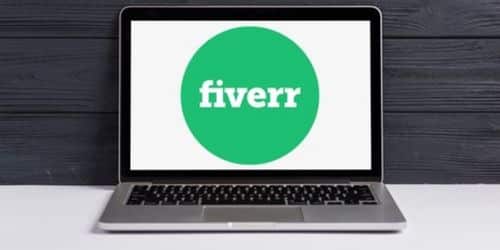Remote working has been increasingly popular in recent years. Fiverr is an online marketplace where you can promote your abilities and get paid for your work. Knowing how to make money on Fiverr can provide you with infinite work opportunities from anywhere in the world.
A common misunderstanding is that Fiverr jobs pay $5. This is not the case because you can establish your own pricing and make thousands of dollars based on your skills and the service you provide.
Continue reading to learn how to make money on Fiverr and discover the most profitable gigs to offer on the platform.
What is Fiverr and How Does It Work?
Fiverr is a global online freelance services marketplace. The Fiverr network connects freelancers (sellers) with individuals or organizations wishing to hire (buyers). Micha Kaufman and Shai Wininger created Fiverr in 2010.
Fiverr is intended to be a digital marketplace with a comprehensive SKU-like services catalog and a quick search, find, and order experience similar to a traditional e-commerce transaction. Fiverr.com is built on a vast collection of over 550 types of productized service listings, dubbed Gigs by Fiverr.
Each Gig has a clear scope, length, pricing, and buyer feedback. Buyers may quickly identify and acquire productized services ranging from $5 to hundreds of dollars, such as logo design, video creation and editing, website building, and blog authoring. This is referred to as a Service-as-a-Product (“SaaP”) model on Fiverr.
Fiverr created its platform to make it simple for buyers to locate and purchase the digital services they want without the need for time-consuming negotiations or pricing uncertainties while providing the best value for money. Simultaneously, Fiverr allows sellers to contact a broad buyer world, spending more time doing what they love and are most excellent at, rather than on-demand creation, contract negotiation, money collection, and other responsibilities of running a digital services business.
Fiverr uses a machine learning algorithm with a dataset on profiling, transactions, and user activity to personalize user experiences, which develops rapidly with the increased buyer and seller interaction. Fiverr says that its business strategy lowers friction and uncertainty for its buyers while allowing sellers to reach a worldwide audience, experience greater flexibility, job choice, and make more money.
How Does Fiverr Make Money?
Fiverr generates money from service and transaction fees, software subscriptions, and course sales.
Fiverr’s business model is to run an online marketplace. The more buyers its marketplace can bring in, the more services vendors will be able to offer. This, in turn, attracts more consumers, a phenomenon known as the flywheel effect.
The general quality of Fiverr’s marketplace rises as more services are offered (as sellers compete against each other for the top spots).
Furthermore, Fiverr ensures that the quality of its sellers is improved by offering them a choice of resources such as online courses or accounting software.
So, in the section below, let’s take a closer look at each company’s revenue stream. Revenue from its other businesses, such as Working Not Working, will be excluded from the analysis.
#1. Service and Transaction Fees
The vast bulk of Fiverr’s revenue comes from service and transaction fees charged to both consumers and sellers.
Sellers are charged a 20% transaction fee. For example, if an order is worth $50, the seller keeps $40 while Fiverr keeps the rest.
Buyers must pay an additional 5% in service costs. To continue with the previous example, the above order would total $52.50, with $2.50 going to Fiverr.
Fiverr’s purpose, like any online marketplace (including its competitor Upwork), is to expose the finest possible services for any search query. As a result, every two-sided marketplace (containing buyers and sellers) must ensure enough supply (in this case, the number of services offered) to satisfy a buyer’s requirement.
Furthermore, by handling the payment procedure as well as service promotion, Fiverr reduces the amount of friction when hiring a freelancer.
Potential buyers may already know how well the service is rated, what services are supplied, and when to expect them before making a purchase. This eliminates a lot of the uncertainty of hiring a freelancer online.
Read Also; HOW DOES PAYPAL MAKE MONEY: Business Models & History
Furthermore, sellers can access millions of buyers without worrying about the money arriving in their bank account (as Fiverr services have to be paid upfront). Additional perks include dedicated Fiverr support, automated invoicing, and revenue-tracking dashboards.
Fiverr has since increased its services to encourage repeat purchases and business customers.
It will debut its Business component in September 2020, allowing businesses to access a pool of vetted freelancers to perform projects. Aside from service and transaction fees, Fiverr monetizes its service by charging companies $149 per year for teams of up to 50 members.
It subsequently introduced Subscriptions a few months later, in February 2021, allowing customers to work with their preferred sellers repeatedly.
#2. Software Subscriptions
Naturally, many of the vendors on Fiverr’s site develop in tandem with the platform (remember the flywheel effect).
As a result, some can establish large firms with several staff.
Workspace, designed by Fiverr, assists company owners in running their businesses while handling dozens of client requests simultaneously.
There are two tiers available: free and unlimited. The Free tier includes only a few capabilities, such as seller connectors, ready-to-use contracts, and payment processing.
Unlimited, which costs $24 per month (or $216 per year), adds editable contracts, business analytics, priority assistance, custom-branded documents, and other features.
Providing merchants with a variety of additional tools strengthens Fiverr’s platform. Due to the costs imposed, sellers are typically incentivized to depart the site once they’ve built up a recurrent client base.
Taking the burden out of client and business process management, on the other hand, gives them a stronger motivation to stay due to time savings (which then can be used to serve more clients).
#3. Course Sales
Finally, buyers and sellers can purchase online courses provided by top achievers in their respective fields.
Tips on viral marketing methods, designing high-converting landing sites, and how to master Facebook advertisements are some examples of classes.
However, Fiverr does not disclose how much of the proceeds from course sales are split between the developer and the platform.
Fiverr Business Model
Fiverr operates on a two-sided marketplace concept, bringing freelancers (service providers) and businesses (service consumers) on a single platform to engage and do business.
Its services are centered on digital services that may be given remotely, and it makes money through successful platform transactions.
Who are Fiverr’s Clients?
Fiverr caters to small and medium-sized businesses (SMBs), or “zero to enterprise” as they term themselves, searching for professional freelance services for ongoing projects in graphic design, digital marketing, programming, video, animation, and many more.
On Fiverr, people who use or purchase services are referred to as ‘Buyers,’ while those who sell (freelancers) are referred to as ‘Sellers.’ Although customers are Fiverr’s primary target market, the company has made acquisitions recently to bring other goods to businesses for content marketing and business development.
What Kind of Values Does Fiverr Offer?
For Buyers
Fiverr brings together a vast pool of freelance professionals enabling buyers or businesses to select the best candidate for their projects or digital tasks on a single trustworthy platform. This massive talent aggregator provides a slew of benefits to its Buyers that set it apart from other freelance marketplaces, some of which are listed below:
1. Save Time and Energy
Buyers save time and effort in gig discovery for their projects when hundreds of digital services are available on a single platform. They can further refine their search by using Fiverr’s intelligent browsing feature and applying several filters to acquire relevant results quickly.
2. Service Transparency
Buyers may browse and uncover all pertinent information about every service or gig listed on Fiverr. There is transparency in pricing and deliverables, as well as the freelancer’s profile, which includes average response time, final delivery, ratings, and skills so that any buyer can determine with certainty whether the candidate meets the specific job criteria or not, which optimizes the entire talent-search process.
3. Access to a Wide Range of Digital Services
Buyers can access digital services in over 500 categories and eight verticals on Fiverr, including Graphic & Design, Digital Marketing, Writing & Translation, Video & Animation, Music & Audio, Programming & Tech, Data, and Business.
4. Dispute Resolution
If a buyer does not receive the requested goods or service, they may request changes if it is included in the deal. Furthermore, buyers can contact Fiverr’s Resolution Centre to address a disagreement or unsatisfactory service.
For Sellers
Sellers, often known as freelancers, form the backbone of Fiverr because they are the user type that provides genuine services to buyers. As a result, to keep people utilizing Fiverr, the company offers a plethora of services and goods, which are stated below:
1. There are no project negotiations or bidding.
The Fiverr search algorithms find and link consumers and sellers without requiring sellers to compete for their services among competing freelancers. Sellers must build an appropriate business profile, upload their jobs and packages, and sit back while Fiverr selects the best buyers.
2. Project Definition
Sellers can learn firsthand what potential buyers expect from them, such as a project description, detailed instructions, essential data, and even a budget. This allows communication between the parties involved and allows the vendor to create a product that will satisfy a buyer.
3. E-Learning Resources
Sellers can also develop in-demand professional skills by taking business and technical courses. These courses are given by specialists in their fields and are primarily aimed at freelancers who want to gain skills that companies require for their projects.
What Are the Primary Services Provided by Fiverr?
#1. Freelancers’ Online Marketplace
Fiverr’s most important offering is the primary online marketplace that connects businesses with freelancers.
The steps below explain how Fiverr’s central marketplace works:
- To begin, a buyer searches a library of gigs offered within a category or sub-category by entering relevant keywords and applying filters such as budget, delivery time, etc.
- They then choose a gig by evaluating the seller’s work scope and selecting the appropriate package (Basic, Standard, or Premium).
- Buyers can also post a gig request, to which sellers can react if they believe they have the necessary expertise.
- After the buyer orders and pays for the gig, plus a 5% service fee, they provide the seller with the exact instructions, descriptions, and files to work on. Both sides can converse throughout the performance.
- Finally, after the job is completed and delivered, and the buyer has not voiced any issues for 14 days, Fiverr “allows the seller to withdraw 80% of the transaction value.”
#2. Learn From Fiverr
Take Note of Fiverr is the company’s e-learning portal aggregates expert-led professional courses. Upon successful completion, a user receives a certification or a badge on their profile indicating their proficiency in the skill.
Any user can explore course catalogs and enroll in a course for unlimited access. If a student is dissatisfied with the system, Fiverr will refund their money within 30 days.
#3. Fiverr Elevate
Fiverr Elevate helps freelancers establish their businesses by providing resources. It is designed as a short video series in which you will learn freelancing fundamentals and receive exclusive bargains on services such as bank accounting and taxes from partner organizations.
Who Are Fiverr’s Most Important Partners?
#1. Sellers
Without the freelancers who sell their services on the platform, Fiverr would be nothing. Even though they are viewed as customers, these freelancers are Fiverr’s most important partners. They are the platform’s foundation that allows our outsourcing website to be genuinely outsourcing.
#2. Affiliates
Fiverr has an affiliate program that pays affiliates up to $1000 for marketing Fiverr and its items to their target audience. Affiliates are Fiverr’s primary marketing partners.
#3. Fiverr Elevate Partners
They are a fine collection of partner companies that provide professional services via Fiverr Elevate.
#4. Payment Gateways
PayPal, Apple Pay, Google Pay, Wire Transfer, and many other payment methods are accepted by Fiverr.
Which Channels Does Fiverr to Provide Value to Its Customers?
Fiverr offers its website and an app for Android and iOS smartphones. Vendors and buyers may log in to Fiverr through a single integrated platform and access their consumer pool. Users can purchase additional items on Fiverr’s affiliated websites, such as Fiverr Learn and {Elevate.
How Does Fiverr Keep in Touch With Its Customers?
As an online marketplace for businesses and freelancers, Fiverr provides users with the resources and tools they need to help themselves (Self-service) and convert clients. At the same time, Fiverr has a community forum and is known to organize various virtual events and provide business growth recommendations to its members, demonstrating that the firm seeks to build a more personal interaction with its community.
Who are Fiverr’s Competitors?
In the gig economy, Fiverr confronts competition from other freelance platforms.
Although competition is fierce, Fiverr continues to be the most extensive online gig economy network for freelancers.
The following websites are among its main competitors.
- Upwork.
- Freelancer.
- 99designs.
- Guru.
- Toptal.
- PeoplePerHour.
- Truelancer.
- Outsourcely.
Conclusion
Fiverr issued a press statement in December 2020 stating that 68% of remote workers are interested in freelance work amid the COVID-19 pandemic.
While the pandemic caused a global economic crisis and massive job losses, the freelancing business has thrived due to the development of remote work, reduced travel time, and a general shift in the mindset of those working remotely.
And Fiverr is capitalizing on this massive opportunity. So much so that the corporation declared in its Fourth Quarter and Full Year 2020 statistics that “revenue in 2020 was $189.5 million, an increase of 77% year over year.”
Micha Kaufman, Fiverr’s founder and CEO, stated in a statement that “in the year ahead, we also intend to continue to roll out substantial products, features, and capabilities, as well as continuing to assist lead and power the worldwide trend toward digital transformation and remote work.” Fiverr is going all out to become the most successful business in the freelancing market.
- FREELANCING BUSINESS: 2023 Models and Ideas to consider starting (+ free tips)
- FREE MONEY TO START A SMALL BUSINESS: How & Where To Get It!!!
- Best online business 2023 [20 ideas + business plans]
- Top best affiliate programs to earn from in 2023 (Updated)
- Best High-Paying Fitness Affiliate Programs In 2023






![[Business Guide] How To Start A Used Car Dealership In Missouri?](https://businessyield.com/wp-content/uploads/2022/03/unnamed-380x220.png)